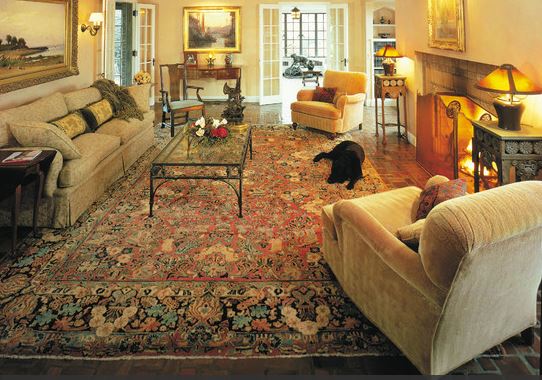SAROUK rugs (SARUQ rugs)
SAROUK rugs (SARUQ rugs) are those woven in the village of Saruk and also the city of Arak, Iran and the surrounding countryside. SAROUK rugs (SARUQ rugs) have been produced for much of the last century. The early successes of the SAROUK rugs (SARUQ rugs) are largely owed to the American market. From the 1910s to 1950s, the “American Sarouk” also known as the “Painted Sarouk” was produced. SAROUK rugs (SARUQ rugs) are characterized by both curvilinear and geometric patterns and come in both traditional and American styles.
SAROUK rugs (SARUQ rugs) get their name from an obscure village in Persia, located twenty miles north of Arak (formerly Sultanabad). Over a short span of history, this village produced some of the most highly regarded antique Persian rugs from the late 19th to early 20th century. SAROUK rugs (SARUQ rugs) are easily recognizable despite their lack of consistent design elements. Most were room sized with central medallions and generally the wefts were blue. The traditional designs consist of Herati, boteh, or gul hannai motifs in either an all-over or medallion layout. The medallion layout could have a hexagonal, oval, diamond, round, or angular floral shape. The most interesting traditional design is a medallion-and-corner layout which consists of geometric yet very naturalistic floral motifs. SAROUK rugs (SARUQ rugs) are very famous, however, it is not easy to determine true SAROUK rugs (SARUQ rugs) from those of neighboring villages and cities. The field colors were cream, indigo or a pale red and floral motif in the field showed multiply shades of orange, green and brown. The short velvet like pile of this unique antique rug style is of excellent quality and wears well.
At the start of the 20th century, international interest in rugs from this region increased production and this style became known simply as “SAROUK rugs (SARUQ rugs).” At this time, a stylized floral all-over design emerged as the most popular of Sarouk patterns. The finest quality has been given the name “Mahajiran Sarouk” (also spelled “Mohajeran Sarouk” or Mehajeran Saruk”). This singular group of Persian rugs stands out through its use of the finest lamb’s wool, which lends a deep luster to its pile, its glowing natural dyes, excellent workmanship and expressive artistry. SAROUK rugs (SARUQ rugs) are of excellent quality. Antique (1900) SAROUK rugs (SARUQ rugs) are of extremely high quality and are being collected by museums and private collectors. After WWII, the quality SAROUK rugs (SARUQ rugs) dropped for a brief period. SAROUK rugs (SARUQ rugs) come in different sizes, but the majority of them are mid-size (4 x 6 to 8 x 10 feet).
The main colors used in the traditional designs are red, blue, burnt orange, ocher, and champagne. The main colors used in American SAROUK rugs (SARUQ rugs) are rich reds and blues. Sometimes the motifs are outlined with a lighter red, light yellow, or turquoise to create contrast between the background and the motifs, especially in the case of open field designs. An intense salmon pink called dughi pink is typical of American SAROUK rugs (SARUQ rugs); this color is obtained by adding yogurt or curdled milk to the dye mixture. Other colors such as soft green, blue, and brown are found in newer SAROUK rugs (SARUQ rugs)
In the same region where Sultanabad rugs are made, you will also find Farahan, Sarouk Farahan, Mohajaran, Sarouk, American Sarouk, and Mushkabad rugs. Although these names are sometimes used interchangeably to describe carpets from this region, there are slight differences between these rugs based on period of production, motifs and pattern, color, thickness and quality. Several are named for the villages and towns that produced them including Farahan, Sarouk and Mushkabad.
New SAROUK rugs (SARUQ rugs) are made from excellent wool, cut medium high to high. Older pieces are often hard, woven in lustrous top quality wool, KORK (baby lamb’s wool), and cut very short to short.
To be able to compete with Kashan in rug commerce, Farahan designed rugs with center medallion motives. Today, these rugs are referred to as Antique 19th century Farahan SAROUK rugs (SARUQ rugs).In the 1920s and 1930s a well-known rug dealer in New York thought that Americans would buy rose-field carpets with blue borders and detached floral motives. During that period, a vast number of SAROUK rugs (SARUQ rugs) with rose-fields and all over floral patterns were woven and exported to the American market. However, the natural dyed rose color did not stand up to the alkaline bath to which new rugs in Arak were subjected in the finishing process. SAROUK rugs’ (SARUQ rugs’) Warps is mostly cotton; wefts is also cotton.
Inspection of the back of SAROUK rugs (SARUQ rugs) is important because the weavers in SAROUK (SARUQ) use Persian knots. In antique SAROUK rugs (SARUQ rugs), you can also find Turkish knots. The quality of the rug depends upon the number of knots, which varies, but usually averages from around 120 KPSI (30 RAJ) up to 475 KPSI(60 RAJ). SAROUK rugs (SARUQ rugs) are among the best looking and finest quality rugs.
Source:
http://en.wikipedia.org
http://www.oldcarpet.com
http://www.houzz.com






